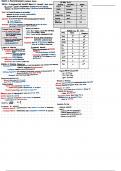Tentamen (uitwerkingen)
NR 228 Exam 1 Nutrition ROKS
- Instelling
- Chamberlain College Of Nursing
NR 228 Exam 1 Nutrition ROKS Chapter 1: Living a Healthy Lifestyle Key concepts to review: 1. What are health and wellness? • Health: the absence of disease or illness, merges and balances 6 physical and psychological dimension of health, physical, intellectual, emotional, social, spiritual...
[Meer zien]












